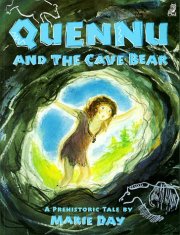|
________________
CM . . . .
Volume VII Number 10 . . . . January 19, 2001
excerpt: As Quennu felt her way forward into the darkness, cold greasy water trickled down the walls over her hands. Soon the tunnel closed in so she had to bend over and then crawl. Sharp rocks cut her knees. When the tunnel opened enough for Quennu to stand up again, she blew her whistle as loudly as she could. But there was no answer, only silence. It was as if the black tunnel swallowed all sound.Quennu, a young girl, fears only one thing in her prehistoric world--the cave bear. A Shaman gives her a bear tooth as a charm to protect her from the bear, but Quennu loses it on the way to the tunnels with her clan. Retracing her steps to look for the charm, Quennu becomes separated from the group. Having found the tooth, she makes her way through the dark passage. She imagines that the bear is near, his scent permeating the cavern. Her heart pounding, Quennu continues along the passage, following the sound of the clan's drums and flutes. When she arrives at the huge cavern, she joins the other cave artists, and, taking paint, moss and sticks, she draws the cave bear with its sharp teeth and curving claws. Children will identify with Quennu as her imagination runs wild and she tries to overcome her fear. Though obviously a work of fiction, but based on fact, this story not only serves to teach youngsters about life in prehistoric times, but it also suggests that, in many ways, children today are not much different from children long ago. Day captures the feeling of the time and the physical setting. Her writing style is quiet and soothing as she tells Quennu's story. The use of simple vocabulary also matches the mood, time and place. A brief, one-page description of the first artists appears on the last page of the book. Rendered in a combination of watercolours and printmaking techniques, the illustrations are inspired by the prehistoric art found in the Caves of Lascaux, in France. In many cases, they look as if they are drawn with charcoal sticks, then filled in with colour. Primitive and full of life, they suit the text and the mood perfectly. All illustrations are double-page spreads. The text appears in a white rectangle bordered by a thin band of colour to set it apart from the illustrations. Recommended. Gail Hamilton is a teacher-librarian at Bird's Hill School in East St. Paul, MB.
To comment on this title or this review, send mail to cm@umanitoba.ca.
Copyright © the Manitoba Library Association.
Reproduction for personal use is permitted only if this copyright notice
is maintained. Any other reproduction is prohibited without
permission.
Published by
TABLE OF CONTENTS FOR THIS ISSUE - January 19, 2001.
AUTHORS |
TITLES |
MEDIA REVIEWS |
PROFILES |
BACK ISSUES |
SEARCH |
ORDER |
CMARCHIVE |
HOME
|
